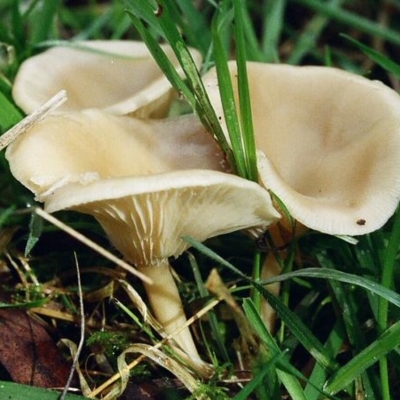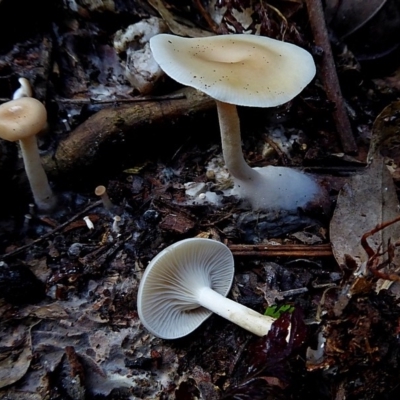Singerocybe clitocyboides
The fruit body is a mushroom, with a cap atop a central stem. The cap (in shades of light brown) may be up to 5 centimetres in diameter and is smooth with a somewhat soapy appearance and feel. It may be shallowly convex when young but with age resembles a shallow funnel. The gills run down the stem a bit (technically, decurrent) and both they and the stem are of a similar colour, somewhat paler than the cap. The stem may grow to 6 centimetres long by 1 centimetre wide and there is a white, cottonwool-like sheathing at the base.
The skin of the cap surface is composed of linear cells (or hyphae, as is the case in numerous mushrooms) plus bladder-like cells that are up to 30 micrometres in diameter.
Spore print: white. There is neither a partial nor a universal veil.
The mushrooms are found amongst leaf litter on the ground or on rotten wood, in various habitats.
The first description of this species (as Agaricus clitocyboides) was published in 1887, based on material collected in Victoria. In 1965 it was moved to the genus Clitocybe and in 2014 to Singerocybe. It is known from Australia and New Zealand and similar species occur in the northern hemisphere.
Look-alikes
This species has no striking naked-eye features to make it stand out amongst the Clitocybe-like mushrooms, making naked-eye identification dubious. However, under the microscope, those bladder-like cells make it an easily identifiable species of 'Clitocybe'.
Singerocybe clitocyboides is listed in the following regions:
Canberra & Southern Tablelands
Species information
- Singerocybe clitocyboides Scientific name
- Common name
- Not Sensitive
- Local native
- Non-invasive or negligible
- Machine learning
-
Synonyms
Singerocybe clitocyboides Clitocybe clitocyboides Singerella clitocyboides
Location information
-
Maps
Oakey Hill






